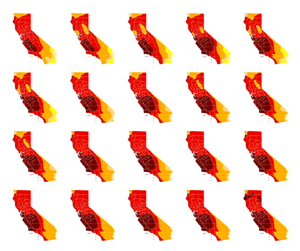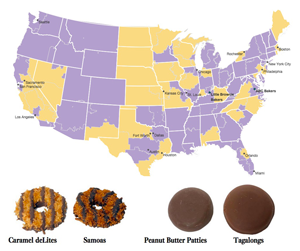Ch-ch-changes: The evolving elements of pop music
Pop music is often considered a reflection of changing culture in the United States — and between 1960 and 2010, songs featured in the Billboard Hot 100 varied greatly. Researchers in England recently analyzed almost all the singles that charted during that period to reveal trends in the evolution of popular music—noting, among other things, that the biggest revolution to occur was the birth of rap in 1991 and that, with the exception of a brief synthesizer-happy period in the 1980s, there’s always been a lot of diversity in American pop.
To construct their evolutionary history of American pop, the scientists looked at quantifiable digital elements in the music that correspond with rhythmic, harmonic, and tonal qualities in the songs, noting where they clustered and how they changed over time.
Below, we highlight some of the easier-to-understand tonal elements they tracked, linking them to particular artists and songs. Several trends in the team’s analysis are also displayed in the graphic below, with each of the approximately 17,000 songs they analyzed represented as a dot. Search by artist and tonal quality. Mouse over chart to see results.
Reading this chart:

1.0
Highlighted track
0.5
Average
0
1960
1970
1980
1990
2000
Hip-hop revolution ignites
Ramps up with the rise of rap and hip-hop in the late '80s and into the '90s, with artists like Busta Rhymes, Ludacris and Snoop Dogg.
Elements: Energetic, speech, bright
The rise and fall of the drum machine
Rises continuously until 1990 as the use of drum machines spreads. Dance, disco and New Wave artists such as the Pet Shop Boys share these tonal qualities. Their frequency declines after 1990 as the reign of the drum machine ends.
Elements: Drums, aggressive, percussive
Manilow couldn't keep the orchestra alive
Think Electric Light Orchestra, the Allman Brothers Band, Supertramp and other '70s powerhouses. Declines in the '80s but sees a resurgence in the 2000s Counting Crows and Coldplay.
Elements: Piano, orchestra, harmonic
Big guitar rocks, rolls, rebounds
Rises and falls in two full cycles with peaks in 1966 (the Turtles, Paul Revere & the Raiders) and 1985 (the heyday of stadium rock groups such as Motley Crue, Van Halen and Cheap Trick). It heads upward once more in the 2000s.
Elements: Guitar, loud, energetic
Mellow '60s and '70s fade, reborn in the '90s
Common in the music of singers like Smokey Robinson, Tony Bennett and Patsy Cline, this musical quality has a resurgence in the 1990s with artists like Madonna and Boyz II Men.
Elements: Calm, quiet, mellow
(As tagged by last.fm users)
Credits: Leaflet, CartoDB
Source: "The Evolution of Popular Music: USA 1960–2010" - Royal Society Open Science
 How what you eat demands more water than you think it does
How what you eat demands more water than you think it does Run the L.A. Marathon without ever breaking a sweat
Run the L.A. Marathon without ever breaking a sweat California's worsening drought
California's worsening drought 6 Girl Scout Cookies you thought you were getting but aren't
6 Girl Scout Cookies you thought you were getting but aren't